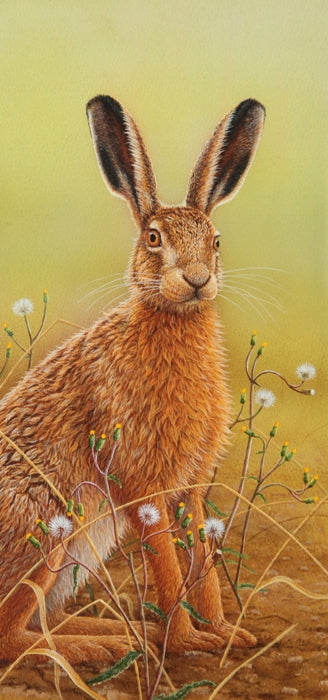Below I've put together a list of some of the best wildlife you can see here and where you can go to see them - illustrated by the paintings they have inspired.
 Hare in Mayweed, print by artist Robert E Fuller. Shop Now.
Hare in Mayweed, print by artist Robert E Fuller. Shop Now. Hares: The Yorkshire Wolds is real hare country. The open grass dales are free-draining and ideal for this agile species. Hares are usually solitary, so if you spot more than one it usually means they are courting. Look out for them on bright days, when the sunshine seems to act as a natural aphrodisiac. When hunkered down they look like a row of molehills, but be patient and you’ll see them explode into action as the males box and chase the females. Although March is the peak breeding season, you can see them box throughout the year.
Where to spot them: Drive along York Lane towards Huggate then follow the Wolds Way on foot towards Millington Pastures. Also see: A pair of peregrines – look for them as they hunt amidst flocks of fieldfares or pigeons. You can also spot barn owls and short eared owls here.
 Red Kite at Deep Dale, art print by Robert E Fuller. Shop Now.
Red Kite at Deep Dale, art print by Robert E Fuller. Shop Now. Red Kites: You can see the spectacular aerial displays of more than 60 red kites as they play a game of chase over the edge of the Yorkshire Wolds. Red kites are unusually sociable birds and surprisingly acrobatic. If you go on a winter's afternoon you can see them swooping into a communal roost. Until recently these beautiful birds were facing extinct but thanks to a restoration project at nearby Harewood House, they have now established a spectacular colony here on the Yorkshire Wolds. Read my post about watching red kites here.
Where to see them: Nunburnholme, near Pocklington. Drive out of the village on the steep road towards Warter. Stop at the passing place on the left. Also see: Buzzards, green woodpeckers and barn owls.
 Barn Owl on Lookout, limited edition art print by Robert E Fuller. Shop Now.
Barn Owl on Lookout, limited edition art print by Robert E Fuller. Shop Now.Barn Owls: Although this species struggles to survive severe winters - and Yorkshire is one of the northernmost reaches of this small species - barn owls are relatively common here on the Yorkshire Wolds. Watch them swoop over hedgerows and rough grassland as they search for their main prey of mice or voles. Their distinctive white colouring makes them easy to spot, as their wings shimmer against dark skies. Although they are essentially nocturnal, you can spot them on early winter afternoons and late summer evenings.
Where to see them: Luckily barn owls are fairly widespread and so any Wolds dale, where the grassland is open, but common places to see them are Millington Dale, Thixendale, and Huggate.
 Short Eared Owl, painting by Robert E Fuller, Shop for more like this here.
Short Eared Owl, painting by Robert E Fuller, Shop for more like this here. Short Eared Owls: Short-eared owl numbers increase significantly over winter as they migrate from Scandinavia to the vole-rich valleys of the Wolds. See them from September onwards and look for them hunting on the wing in the afternoons, when they are at their most active. Numbers fluctuate but I’ve seen up to seven near my gallery in Thixendale.
Where to see them Follow signs to Millington Wood from the village of Millington. Go past the woods, parking near the pond. Walk up the valley on foot. Scan dale sides with binoculars and check out bushes and fence posts too. Also see: water rail, bullfinch, kingfisher, brown hare, barn owls, red kites, buzzards and roe deer.
 Otter, limited edition print by Robert E Fuller. Shop Now.
Otter, limited edition print by Robert E Fuller. Shop Now.Otters: Otters are so secretive you normally only catch the wake that their bodies create as they swim across water, or the line of bubbles that trace the otter’s movement underwater. If you spot this then watch carefully for the moment the otter pops its head up for air. The waterways all across the Yorkshire Wolds are home to otters, but they are very secretive - if you are lucky you can see their cubs playing and splashing in shallow water.
Where to see them: The best place to spot one is at Tophill Low Nature Reserve, situated four miles from Watton village on the A164 Beverley to Driffield road. Otters are regularly seen all over this excellent reserve that surrounds the Yorkshire Water treatment works, especially from the Southern Marsh hides. Read my blog on the day I spotted one here. Also see: 160+ bird species recorded here including massive flocks of black headed gulls, kingfishers and marsh harriers

Puffins and Gannets: There's something inexplicably joyous about spotting a puffin in the wild. They are such fun looking birds, with their smart black and white plumage, bright orange beaks and waddling walks. The Yorkshire Wolds coastline at Bempton is one of the best places to spot them and the RSPB site at Bempton Cliffs is also host to the largest mainland colony of gannets in the country.
Where to see them: Every summer, the RSPB site at Bempton Cliffs teams with gannets, puffins, guillemots and other sea birds. You can see them from the top of this steep chalk cliffs or take boat trips to watch them from below. Read my blog about watching puffins here.





